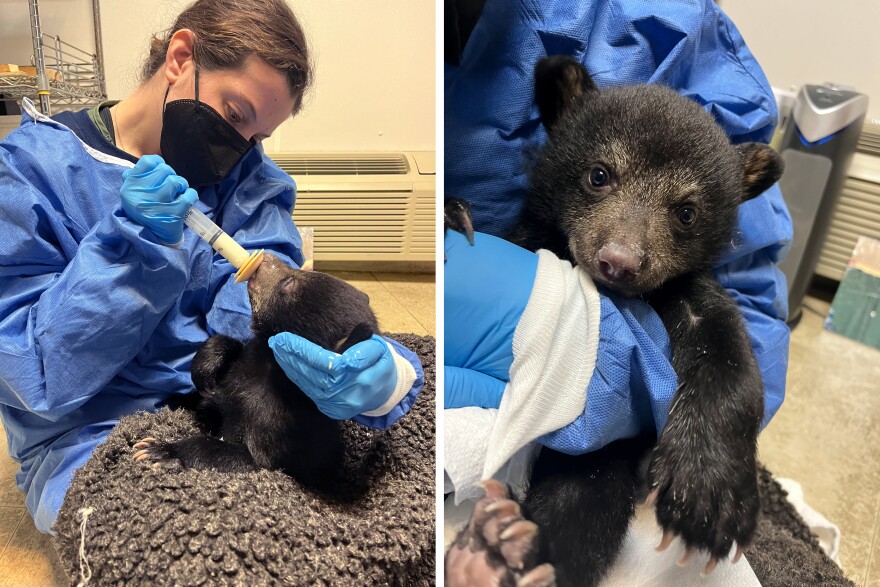Black bear cubs that are orphaned in Virginia are brought to the Wildlife Center in Waynesboro, where they’re raised by human surrogates until they can return to the wild. WMRA's Randi B. Hagi reports.
[sound of utility vehicle driving along path]
It's a cold afternoon in January. The Wildlife Center's 'bear mom' team drives a utility vehicle up to the black bear complex to toss in a meal of fruit and mixed nuts from the tower overlooking the enclosure.
[sounds of nuts scooped into buckets]
The team's seven charges are one-year-old black bears who came to the center last spring. They estimate the largest of them, nicknamed "Double Green" for the color of his ear tags, now weighs 200 pounds. At the peak of their winter bulking, Rehab Team Lead Mac Stewart says the group was eating about 200 pounds of food a day.

MAC STEWART: We get tons of donated produce from local grocery stores, and they can pretty much eat any of the produce – the fruits and vegetables we give them on a daily basis, and then we introduce a ton of protein as well … like natural whole-prey items like chick or mice or rats … fish, of course. Nuts are a big one. That's something that, bears eat tons of acorns and nuts in the wild, so that always tends to be a fan favorite. Live insects, so mealworms, superworms, things like that that they would naturally be foraging for.
The team has strict protocols for how to and who can interact with the bears so they don't get acclimated to being around humans. So I sent my audio recorder up with the caretakers to capture the masticatory melodies of the bears chewing on nuts and grapes.
[sound of bears crunching and munching]
Rehab Supervisor Alejandra Olvera explained that when very young cubs are first admitted to the center, the care team has to balance giving them enough socialization with not treating them like pets.
ALEJANDRA OLVERA: Cubs naturally are not solitary animals. They get a lot of parental care, and usually sows will have one to two cubs, maybe three cubs. … If we do not provide that stimulation of socialization, that cub, behaviorally, is not going to develop appropriately. … We try to encourage as many natural behaviors as we can, either by just walking around the room with them so they can chase us, because that's what they would do with mom. … We try to introduce a lot of natural things like leaves, any thing that they could potentially find interesting, a lot of smells.

One big rule – no conversations around the cubs.
OLVERA: We try to diminish any human chatter – that's what we call it – because that's what we don't want them to get used to. Once we get a second cub, it becomes easier, because we step back a little bit and let them do their own cub play and encourage their behavior together while we step away.
The center works closely with the Virginia Department of Wildlife Resources on bear cases, and determining when a baby bear really does need to be admitted. Double Green, the big boy we mentioned earlier, came in from Wythe County last March.
OLVERA: He came from a brush fire, so he was actually found in his den, and they saw the mom just flee away from the scene. … In this instance, the fire was pretty out of control in that area, and they knew it was not safe to keep the cub in the den, and the mom was more than likely not going to safely return.
Two sets of siblings were brought in after their mothers were killed by cars – including three female cubs from Charlotte County.
OLVERA: They had seen cubs with that sow before she was confirmed dead, and for sure they had seen two of them running down the highway. Those two were brought in, and one of the persons … they were sure there were three cubs before they called … so they kept exploring the area, and within a day, or maybe it was two days, they found that single cub … in a tree, very scared.

Olvera said there's a hierarchy within the seven, but this year's group is unique in how well they all get along.
OLVERA: This group specifically, it's very tight-knit. … There's no separation within the seven.
The bears get a variety of natural and artificial enrichment items.
STEWART: … Lots of logs and branches, lots of fresh browse we'll cut daily. … We gave them a bubble bath last year, so they were able to play and experience the foam and the bubbles, and that also helped them explore water. … A bin that was full of leaves that we threw mealworms and other insects in and various food items.
Two of the cubs still needed to be bottle-fed when they arrived. When they're ready to be released, the DWR will try not to release the "bottle babies" together – if you've ever bottle-fed a livestock animal, you know that ornery, lovable critter usually isn't as adapted to fend for itself as one raised by its animal mother. But, for Double Green and Double Orange –
OLVERA: They're the ones who first started building their den. You know, their denning behavior is so cute to watch, because they'll start gathering leaves, and that's something very natural. The first time I saw one of them do that, I was very excited, because it's a tiny thing, but it's something that – oh my god, we did something right, because they're thinking like bears.
These ursine adolescents will be released back to the wild this spring – just in time for this year's cub cohort to arrive.



